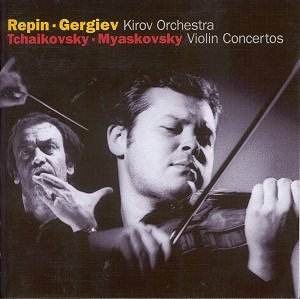All credit to Repin and Decca for introducing a new
generation to the Miaskovsky concerto. That they have done this with
the Tchaikovsky as a coupling betrays the corporate nerves associated
with rare repertoire projects. I do not have a problem with that if
it delivers a nugget as valuable as the Miaskovsky even if, strictly
at a repertoire level, I might have preferred to have say the Shebalin,
Shtogarenko, Steinberg, Ivanovs (what a work!) or Taktakishvili instead
of the Tchaikovsky.
My shelf choices for the Tchaikovsky include the Oistrakh
(BMG-Melodiya), Kogan/Paris Conservatoire (EMI) and even the Campoli
- corrupt edition and all. The Repin is a smashing performance taken
at speed with intoxicating accelerations and seismic triple fortes.
In the first movement at 8.52 Repin shows the torque of a Lamborghini
yet maintains the articulation of a watch repairer - speed and the sharpest
of etching. The Kogan, for all its ‘grey hairs’, sounds very good while
the Oistrakh is marginally more 'controlled' - less volcanic but just
as passionate.
As Andrew Huth points out in his notes the Miaskovsky
concerto was written between two lighter symphonies - the jollyish Nineteenth
for windband and the folk-song Eighteenth. It is a work in which Miaskovsky's
penchant for reflective steppe loneliness (try the poetic sections of
the Sixth and Seventh Symphonies) meets virtuosity and fantasy. Aristocratic
bearing, elegance (try 3.47 in the second movement) and Tchaikovskian
passion are part of the picture. Another is its revelling in the exotic
veering between the First Violin concertos of Szymanowski and Prokofiev
- especially the latter. The Concerto is warmly done and warmly recorded.
A typically Russian passion blazes through the work like lighter spirit
in a forest fire. The brass are vivid - brash even - without the loveably
excessive bray once beloved of Konstantin Ivanov and Boris Khaikhin
and the USSRSO.
This is the only all digital version of the Miaskovsky.
You can still get the mono Oistrakh version on Pearl GEMM CD 9295
(ADD). The Pearl version equates in authority to Sammons/Testament in
the Delius and Menuhin/Elgar in the Elgar concerto. It also happens
to be an extraordinary performance which all Miaskovskians must have.
Hors de combat but still desirable is the deleted Olympia (OCD134 AAD)
in which Grigori Feigin is with the USSR Radio SO condcuted by
Aklexander Dmitriev. It is coupled with the 22nd Symphony written four
years after the Concerto. Not unsurprisingly the tone of the orchestra
sounds if not meagre then certainly weedy by comparison with the full
spectrum sound of the Repin/Gergiev.
For those of you who love the Tchaikovsky but gaze
askance at the Miaskovsky be reassured - it is a rather old-fashioned
and aristocratically romantic work with rattling bravura and overflowing
passion. Give it a chance and you will be won over. It is no pocket
concerto either - both in duration and mood Miaskovsky intended this
work seriously; neither scholarly nor shallow.
These are both high octane readings drawn from live
concerts. I did not detect any coughing; no applause either, for that
matter.
Rob Barnett
Comparison of movement timings (taken from liners not stop watched)
| Oistrakh | Feigin | Repin |
| (Pearl) | (Olympia) | (Philips) |
| I 18.40 | 18.57 | 19.34 |
|
| II 10.11 | 10.14 | 9.39 |
| III 7.40 | 7.24 | 7.40 |
